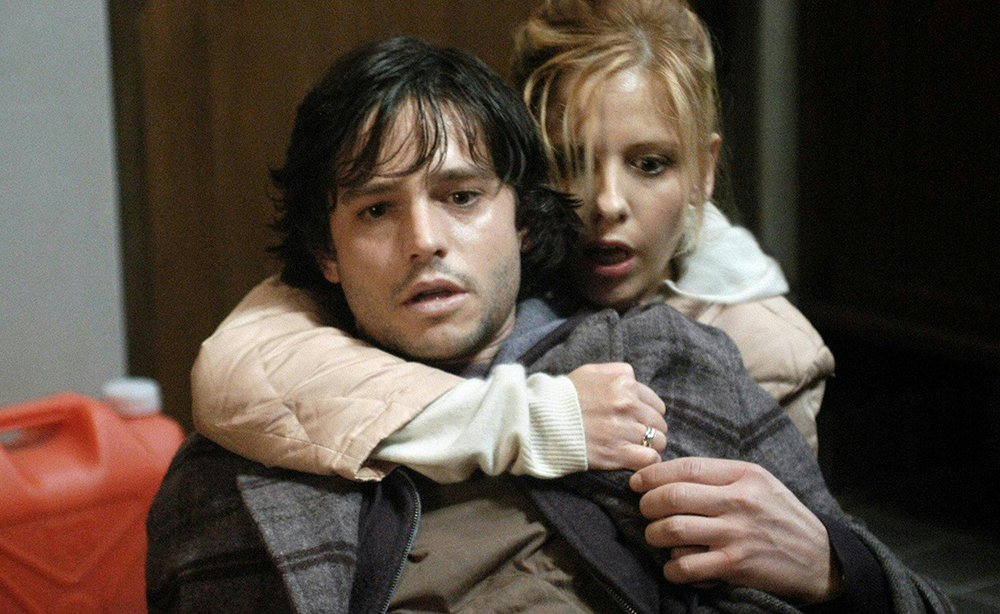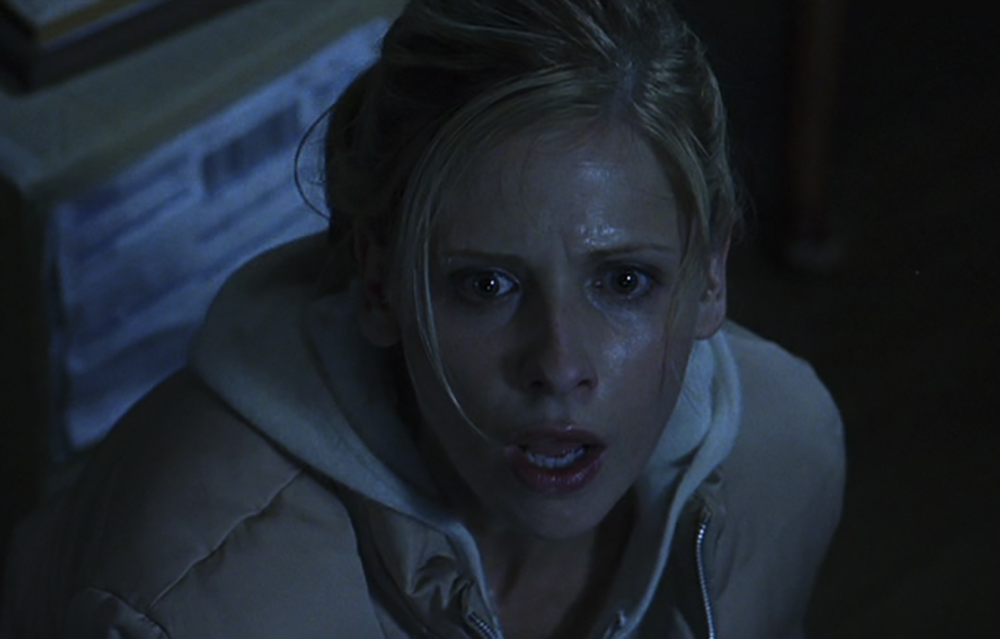Sarah Michelle Gellar was still in the spotlight when “The Grudge” was released, only five years past “Cruel Intentions.” The charm—if that word applies—with Director Takashi Shimizu’s 2004 horror film is her restraint. In fact, though it stars popular actors of the time, it’s a slow-burn supernatural thriller that is creepy and procedural. It’s atmospheric and tempered. And though it starts with a popular American actor (Bill Pullman) jumping to his death, the film is uniquely Japanese. Shimizu wrote the original screenplay for his 2002 Japanese film, and this remake is more of a higher budget reimagining than a redux. Of the other Japanese horror films produced by Hollywood (“The Ring,” “Dark Water,” and “One Missed Call”), this was the only one to remain filmed in Japan.
For some reason, that fact makes this film creepier. Shimizu (along with co-writer Stephen Susco) set the stage well. Karen (Michelle Gellar) has just moved to Tokyo to be with her boyfriend, Doug (Jason Behr), who is studying to be an architect. She volunteers in a welfare office aiding elderly or ailing persons (her supervisor is Ted Raimi, Producer Sam Raimi’s brother). She ventures into the eerie house that acts as this film’s epicenter to take care of a couple’s ailing mother. The shots are still and quiet, and everything here has a greenish-grey tint to it. Even the Columbia Pictures logo at the film’s opening looks old and dated. And while Michelle Gellar and Behr could have distracted from the idyllic Japanese surroundings, Shimizu and Cinematographer Hideo Yamamoto use it to make us—likes the film’s protagonists—feel isolate and alone.
A Mystery to Unwrap
“The Grudge” presents a mystery in the shape of a house, using present and past to tell its story. The thing that works about Shimizu’s film is that you never get the whole story. And maybe that’s the point. In fact, even the film’s plot description is a red herring. “The Grudge” isn’t about a rage-filled entity or curses that follow, like in David Robert Mitchell’s “It Follows.” Rather, it’s about exponential trauma, a trauma so horrific it has nowhere to go but stand still and repeat itself. The story behind that trauma takes Shimizu and Gellar most of the film’s run-time to expose. The film’s winning argument is it doesn’t happen in grave climax, but creepy proceedings drawn from its lingering atmosphere.
That atmosphere follows us during flashbacks leading to “this” story’s beginning, with an American family moving into the cursed house, of course not knowing it’s cursed. They consist of Jennifer (Clea DuVall), Matthew (Michael Mapother), and Matthew’s ailing mother, Emma (Grace Zabriskie). When we first meet Emma (prior to this scene), she’s in much worse shape. However, flashing back in time doesn’t do much to fill us in. She “sleeps all the time,” per Matthew, but Jennifer often has a different view. That is, of course, until Jennifer begins to discover horrible things in the house while Matthew is at work. These involve a hissing cat, moving shapes, and other, worse things which shouldn’t be given away. It’s clear something inhabits the house, and the scenes are creepy yet often obvious in their presentation.
Drawing from Japanese Source Material

I haven’t seen “Ju-on: The Grudge”—this film’s source material—but that film’s $3.5M budget has been upgraded to $10M for this film, and I’m sure most of that went to landing Michelle Gellar and the film’s special effects. The film is odd in that its photography of Tokyo, the movements of its cast, and the dull greyish-green it layers over everything gives it a slow, purposeful feeling. Yet the film’s CGI often flies in the face of this, often showing when it should be telling. But therein lies the film’s strength: it’s not really showing or telling something we can understand. We know that some kind of curse is stalking Karen and others associated with the house. But we’re not sure if it’s only contained to the house, or if it moves, and why. Amidst this, Karen’s supervisor has a run-in with an entity and Doug does a good job being a supportive partner as Karen’s mental health suffers.
“The Grudge” is based on the aforementioned “Ju-on,” and what makes “The Grudge” feel jumpy and almost malaise-filled lies in the fact that Shimizu’s original film was actually the middle of a three-parter. We’re only privy to a small part of the story—in this case Karen’s—and we’re the better off for it. Michelle Gellar is tasked with most of the lifting in this film, and she handles it well. She doesn’t steal the scenes, but becomes part of them. Her ‘other’ status as an American trying to learn Tokyo lets her blend into the film’s proceedings. Aside her, a police detective (Ryo Ishibashi) carries most of the rest of the film. He seems not to blink at his discoveries—no matter how ghastly—and with just a look lets us know he knows more than he lets on. His acceptance sets the film’s tone, well before he tells Karen what is really at stake. But by then it feels too late.
Michelle Gellar and Ryo Ishibashi are Pleasing

“The Grudge” is a good movie. It’s not great—but maybe it’s not supposed to be. It’s not horrific but unnerving, and perhaps along the way we lost sight that that’s what horror films ought to be. There are plenty of creepy parts in Shimizu’s films, but it always seems to pull back when it speeds up. That’s a good thing. Like Matt Reeve’s “The Batman,” “The Grudge” feels like a portrait of its proceedings rather than becoming overstuffed with Hollywood trappings. While it features a generous use of CGI, the movie feels as atmospheric as “It Follows” with the feeling of un-safety offered in “Final Destination,” but without that film’s Hollywood flash.
“The Grudge” feels like an indie. Its events begin and end, yet features a malaise that lingers, letting you know maybe it never will end. Its acting is apt and its cinematography is patient and pensive. There’s a horror to discover here. That Shimizu and company offer that to us in part, and want us to use our imagination to fill in the rest, is what ultimately makes the film succeed.
“The Grudge” is available to watch on most streaming networks.



